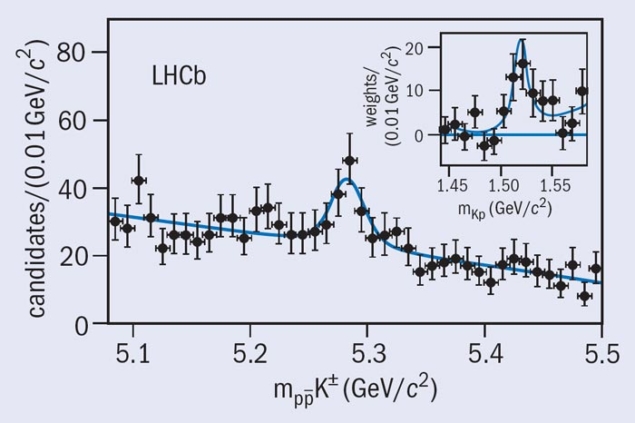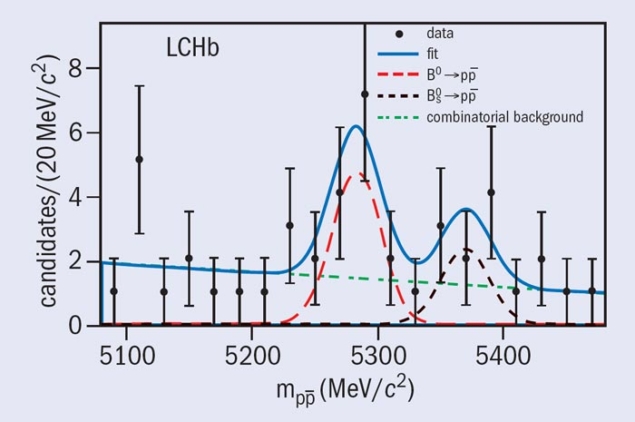The LHCb collaboration has made the first sightings of the decay of B mesons into two baryons containing no charm quarks. While the collaboration has previously reported on multibody baryonic B decays, these are its first results on the rare two-body charmless modes and will help to address open questions concerning baryon formation in B decays.

Baryonic decays of B mesons were studied extensively by the BaBar and Belle experiments at SLAC and KEK, respectively. The measured branching fractions are typically in the range 10–6–10–4, with charmless modes at the low end of this range and those with charm having larger branching fractions. Decays with double-charm final states have branching fractions up to 10–3 in some cases, which is a surprisingly large value. The channel B+ → ppK+ was the first charmless baryonic B-meson decay mode to be seen, in 2002 (Belle collaboration 2002). Soon after, Belle struck gold again with the first observation of a two-body baryonic B decay, B0 → Λcp, which manifestly has charm (Belle collaboration 2003). However, there were no signs of charmless two-body baryonic decays of B mesons until now.
The suppression of low-multiplicity compared with higher-multiplicity decay modes is a striking feature of B decays to baryons that is not replicated by their two-body and three-body decays to mesons. It is also a key to the theoretical understanding of the dynamics behind these types of decays.

The LHCb collaboration used the 1.0 fb–1 data sample collected in 2011 to study the proton–antiproton spectra with or without an extra light meson – a pion or a kaon. Figure 1 shows the invariant mass distribution of ppK+ candidates in the pK+ mass window 1.44–1.585 GeV/c2, where a B+ → ppK+ signal is visible. The inset shows the pK+ invariant mass distribution near the threshold for B-signal candidates weighted to remove the non-B+ → ppK+ decay background.
The analysis reveals a clear Λ(1520) resonance, with the branching fraction for the decay chain B+→ pΛ(1520) → ppK+ measured to be close to 4 × 10–7 (LHCb collaboration 2013a). With a statistical significance exceeding 5σ, the result constitutes the first observation of a two-body charmless baryonic B decay, B+ → pΛ(1520).
Figure 2 shows a fit from a related analysis, searching for B → pp decay (LHCb collaboration 2013b). An excess of B0 → pp candidates with respect to background expectations is observed with a statistical significance of 3.3σ, giving a measurement of the branching fraction for B0 → pp = (1.47+0.71–0.53) × 10–8. No significant signal is observed for B0s → pp but the current analysis improves the previous bound on the branching fraction by three orders of magnitude.
Further reading
Belle collaboration 2002 PRL 88 181803.
Belle collaboration 2003 PRL 90 121802.
LHCb collaboration 2013a LHCb-PAPER-2013-031 arXiv:1307.6165 [hep-ex].
LHCb collaboration 2013b LHCb-PAPER-2013-038, arXiv:1308.0961 [hep-ex].





